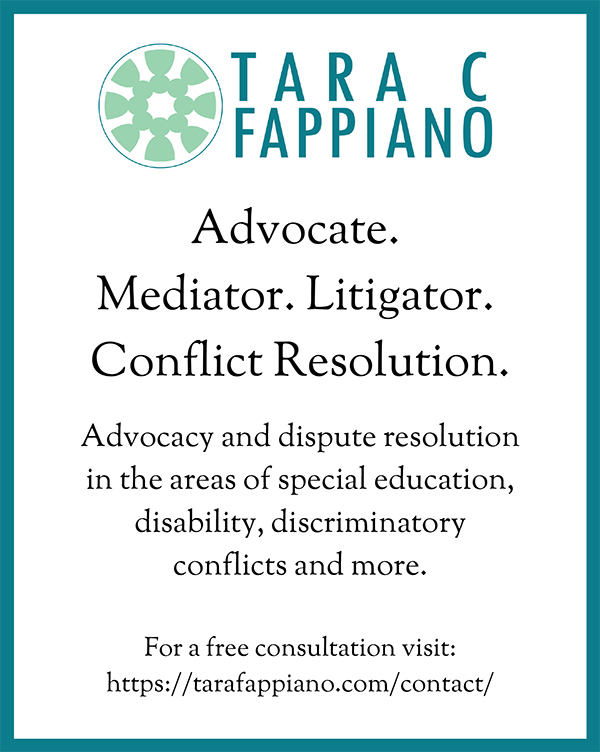Whether you are a parent, guardian, or educator, you have likely faced some sort of conflict involving a student. Conflicts took many shapes and sizes during my son’s special education school experience, and now as he attends college. Sometimes conflicts are with the people involved, other times they involve the task. Sometimes conflicts are real, other times perceived. Resolving conflict constructively undoubtedly leads to better educational outcomes for students.

Facing Conflict
Conflicts arise in many ways, but most can be categorized as “relationship” or “task-related.” With a relationship conflict, the persons involved are incompatible somehow. In a school environment, it is not necessarily realistic to change the players, nor does doing so always resolve the conflict. Focusing on a relationship conflict may seem easier than addressing what might be a task-related, or cognitive, conflict. In education, that might be when the work styles, or perhaps the student’s cognitive or learning abilities, conflict with the expectations or means of accessing education in the classroom. Avoiding conflict because of fear of another’s emotional response, or engaging in conflict to try to trigger an emotional response, are two ends of a spectrum. Neither choice best serves students in the classroom. Both choices tend to lead to the same result – a worsening of the situation for the student.
To face conflict constructively, consider some factors:
Who will you approach? With a classroom conflict, it is likely better for a parent to speak to the teacher, at least initially. Saying nothing for fear of being perceived as a complaining parent may mean no one addresses the problem. Alternatively, going over a teacher’s head to an administrator who does not have personal knowledge of the situation may delay resolution and create an emotional response in the teacher.
Who is going to engage? Consider a situation in which a parent and teacher have had several conflicts during one schoolyear. It may be that there is a relationship conflict which makes constructive conversation difficult. Deciding to bring a new voice or perspective into the discussion may help bring about resolution. It may bring different solutions to the table. It may allow presentation of issues so the parties might be more receptive to a different approach.
How might you approach the conflict? The way that one approaches a conflict sets the stage. Today, educators and parents are reachable in a myriad of ways – email, text, Google classrooms, phone calls, and others. Choosing how to initiate discussion and in how much detail should be intentional. For example, expect a very different reaction to a brief email asking that you make some time to talk than the reaction to a 10-page, single-spaced, detailed email offering one solution you have decided is the only correct one. Similarly, dropping a bomb on a parent at pick up/drop off time, in person, may create anxiety, stress, fear, and urgency; all heightened when not discussed in more detail soon thereafter. I also try to discourage any long email discussions, which rarely lead to resolution. In-person meetings, once an issue is introduced and the right people are involved, tend to be more productive.
Other Obstacles? There are a great many other factors, ranging from language barriers to family dynamics to historical experiences with prior conflicts to cultural/social concerns to others, that might stand in the way of resolution. Considering whether there may be other obstacles, then trying to understand and work through them, shows respect for the other party from the first interaction. That respect builds trust, an important component of resolution.
Breaking Down the Conflict
In virtually every conflict, there are several stages or parts.1 Here, I am focusing on the story and the emotion.
What happened? Maybe this is simple – most of the time it is not. There may be different versions of what occurred or opinions about why. As the issue is discussed, different or new details arise. Others may join the conversation and add information. Everything that is said is relevant to some degree. Some details are facts. Other statements may signal an underlying bias, emotion, opinion, or perspective driving the person’s decision making. I always encourage an initial period in which both sides can share. This creates an environment of mutual respect and understanding. I also find it helpful to let the person attending the meeting know that they will have this chance to share, so they can prepare. Then they tend to come to the meeting with a more constructive mindset.
How you say something is often more important than what you say. For example, using hyperbolic phrases like “you always” or “you never” signal drama, emotion, exaggeration – all burying the real issue. This language may cause the other person to tune out, or the issue is too expansive for there to be meaningful discussion. If you are on the receiving end, the discussion of the things you “always” or “never” do, while hard to hear, may mean there is a larger issue below the surface standing in the way of resolution.
Phrases like “I want” or “I need” or “you have to” also do not lead to constructive discussion. First, what a parent or an educator wants or needs is not necessarily what the student needs. The statement, “I need you to email me every day about Johnny,” may generate a very different reaction than: “It would be helpful for you to email me about Johnny’s progress on that topic because during my workday, your school day, I cannot connect. Then, I can discuss that topic with Johnny each evening. If I have questions or concerns, we can plan next steps.”
There is also a tendency in a conflict to want to blame someone for the problem. An analysis of the factors that may be contributing to a situation is more constructive. For example, blaming a teacher for having 30 students in a classroom without help is not constructive. But that situation may explain why the student is having difficulty attending to a task, or why the student performs differently when at their own quiet desk at home.
How Do We Feel? It is natural for parents to feel significant emotion when speaking about their child’s performance, behaviors, challenges, and inconsistencies in the classroom. They will feel, and want to express, emotion in these discussions. Some of those emotions may be quite strong, even unexpected. I have come to realize that my reactions to my son’s autism diagnosis were akin to the stages of grief. I grieved the loss of the educational journey I expected for him, while struggling with how to make the best choices, when I barely understood what it all meant. As time went on, when we were seemingly on track, there would be some new situation with a whole new set of challenges and frustrations. I now know this is a lifelong journey for my son and for me as a parent – it does not change my emotions. But how I now express and manage those emotions when resolving conflict has led to the best results for my son.
If possible, give the decision-making process some time. That time spent processing emotions probably will lead to a more sustainable resolution. If high emotions are impeding your ability to make clear decisions, try to sleep on it. Educators are also better served when they allow parents time to process. Resolution always leads to better educational outcomes.
Tara C. Fappiano is an advocate, mediator, conflict resolution coach, and attorney. Using conflict resolution techniques and collaborative dispute resolution practices, she works with the special needs community to help with issues that arise with special education and other services. She also offers conflict management coaching and mediation for organizations, non-profits, businesses, school districts and related entities. For more information, email tcf@tarafappiano.com, call (917) 923-2330, and visit www.tarafappiano.com.
Footnotes
- Patton, Stone, Heen, “Difficult Conversations-How to Discuss What Matters Most” (conversations three parts: 1) what happened? 2) feelings/emotions, and 3) identity).






